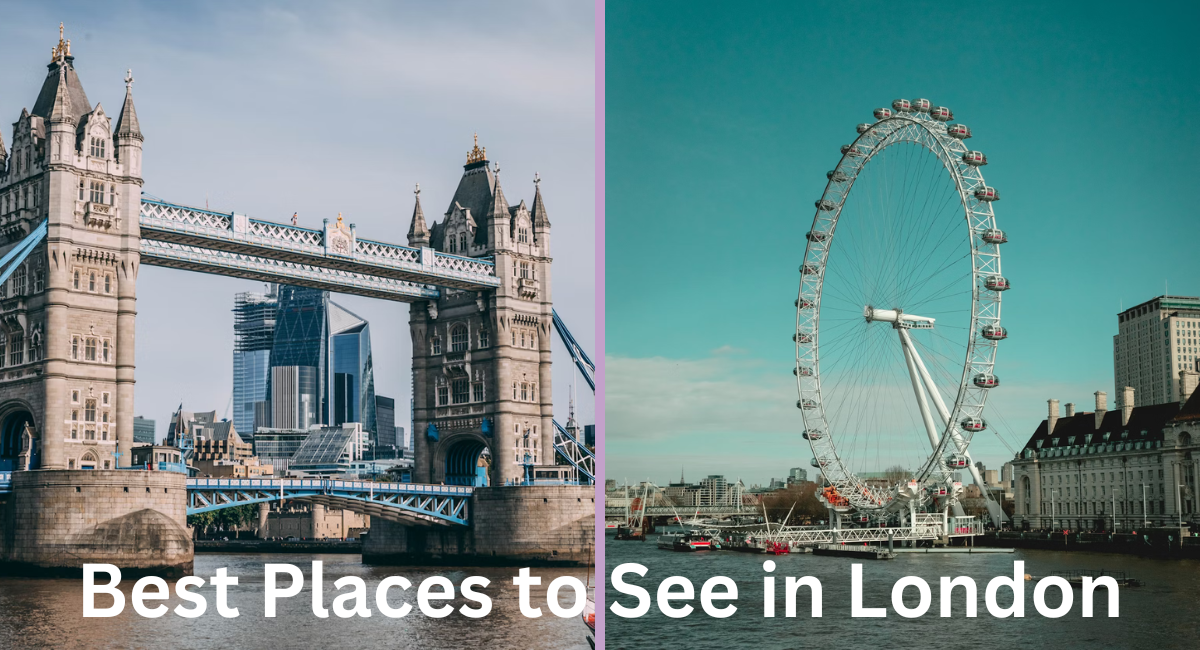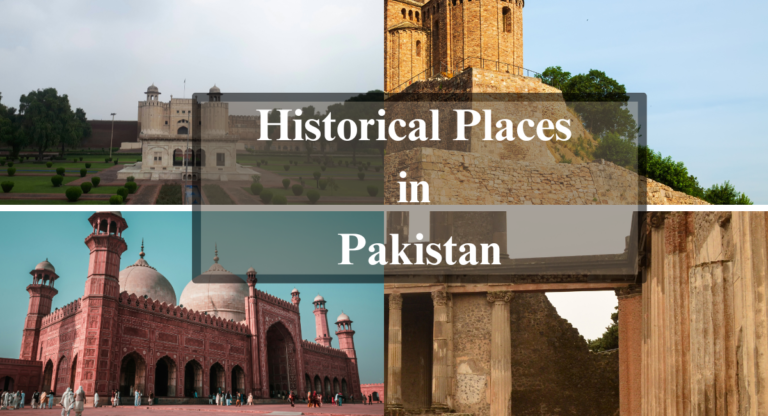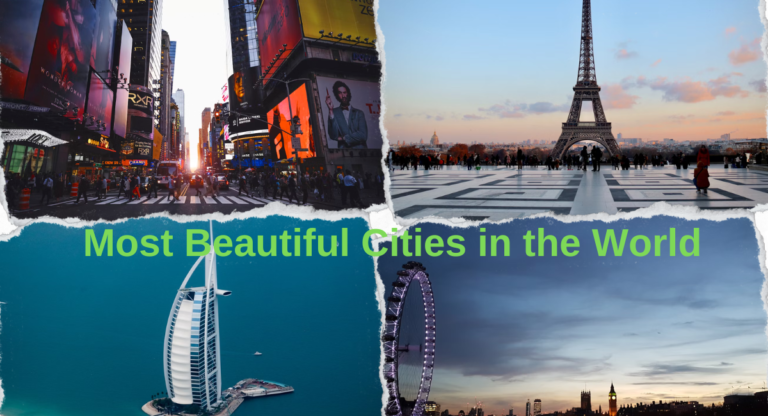Exploring the Best Places to See in London for 2024
As one of the most vibrant and historic cities in the world, London offers a wealth of iconic landmarks, cultural treasures, and hidden gems waiting to be explored. Whether you’re a first-time visitor or a seasoned traveler, London’s diverse neighborhoods and attractions promise something for everyone.
Join us as we explore the Best Places to see in London, ensuring you make the most of your visit to this dynamic and captivating city.
List of the Best Places to See in London
The following is the list of the Best Places to see in London:
- Tower of London
- The London Eye
- The National Gallery
- Buckingham Palace
- St Paul’s Cathedral
- Westminster Abbey
- Hampton Court Palace
- Tower Bridge
- Warner Bros. Studio Tour London – The Making of Harry Potter
- Kew Gardens
- Big Ben
- Madame Tussauds London
- The London Dungeon
- The Houses of Parliament
- Royal Opera House
1. Tower of London
The Tower of London, a historic fortress in central London, dates back to William the Conqueror in the 11th century. It’s known for its iconic White Tower, built around 1078, which has served as a royal palace, prison, and treasury. The Tower houses the Crown Jewels, including the famous Koh-i-Noor diamond.
Tourists flock to see the Yeoman Warders, or Beefeaters, in their distinctive uniforms. The Tower’s grim reputation as a prison is highlighted by the stories of famous prisoners like Anne Boleyn and Sir Walter Raleigh. The Tower of London is a UNESCO World Heritage Site and attracts millions of visitors annually.
Visitors can explore the Medieval Palace, and the Bloody Tower, and walk along the walls for stunning views of the Thames River and London skyline. The Tower also hosts events such as the Ceremony of the Keys, a nightly ritual that has taken place for over 700 years. Whether for its history, architecture, or royal connections, the Tower of London remains a must-see destination for history enthusiasts and tourists alike.
Also Read: London vs Berlin: Which City Is Best?
2. The London Eye
The London Eye, also known as the Millennium Wheel, stands tall on the South Bank of the River Thames. It opened to the public in 2000 as a celebration of the new millennium. Designed by architects David Marks and Julia Barfield, this giant observation wheel reaches a height of 135 meters (443 feet).
Each of its 32 capsules represents one of London’s boroughs and can hold up to 25 people. A complete rotation takes about 30 minutes, offering panoramic views of the cityscape, including landmarks like Big Ben, Buckingham Palace, and St. Paul’s Cathedral.
The London Eye has become one of London’s most popular tourist attractions, drawing millions of visitors annually. It’s especially spectacular at night when it’s illuminated with colored lights, adding to its allure. Tickets can be booked in advance to avoid long queues, and visitors can even enjoy special experiences like champagne flights or private capsule hire for events.
For tourists, the London Eye provides a unique perspective of the city and is a memorable experience for anyone visiting the British capital.
Also See: Most Dangerous Cities in the UK
3. The National Gallery
The National Gallery, located in Trafalgar Square, London, is one of the world’s leading art museums. It was founded in 1824 and houses a collection of over 2,300 paintings dating from the mid-13th century to the early 20th century. The gallery’s impressive neoclassical building is a central feature of Trafalgar Square.
Among the masterpieces, visitors can see works by renowned artists such as Leonardo da Vinci, Vincent van Gogh, Claude Monet, and Rembrandt. Highlights include Van Gogh’s “Sunflowers,” Leonardo’s “The Virgin of the Rocks,” and Botticelli’s “Venus and Mars.”
Admission to the National Gallery is free, making it accessible to everyone. The gallery also offers guided tours, audio guides, and educational programs for visitors of all ages. Special exhibitions, which sometimes require a ticket, are held throughout the year, showcasing specific artists or art movements.
For tourists, the National Gallery provides an enriching cultural experience and a chance to see some of the most famous paintings in art history. Its central location makes it easy to visit, and its extensive collection ensures there’s something for everyone to appreciate.
4. Buckingham Palace
Buckingham Palace is the official residence of the British monarch in London. Built in 1703 as Buckingham House, it became a royal residence in 1837 with Queen Victoria. The palace has 775 rooms, including 19 staterooms, 52 royal and guest bedrooms, 188 staff bedrooms, 92 offices, and 78 bathrooms.
The Changing of the Guard, a daily ceremony in the summer and every other day in the winter is a popular attraction. Visitors gather to watch the colorful and precise military display.
During the summer months, parts of the palace are open to the public. Tourists can explore the State Rooms, which are lavishly decorated with paintings, sculptures, and furniture. The Throne Room, used for formal occasions, and the Picture Gallery, displaying works by artists like Rembrandt and Rubens, are highlights.
The palace gardens, spanning 39 acres, feature a lake, a tennis court, and a helicopter landing area. Annually, about 50,000 guests are invited to various events, such as garden parties and receptions.
Buckingham Palace is a symbol of the British monarchy and a must-see for visitors to London, offering a glimpse into the royal lifestyle and British heritage.
5. St Paul’s Cathedral
St Paul’s Cathedral, an iconic symbol of London, is an Anglican cathedral located on Ludgate Hill. Designed by Sir Christopher Wren, it was completed in 1710 after the Great Fire of London destroyed its predecessor. The cathedral’s magnificent dome, one of the largest in the world, rises 111 meters (365 feet) and dominates the skyline.
Inside, visitors can marvel at the grand nave, intricate mosaics, and the Whispering Gallery, which carries whispers around its circumference. Below, the crypt houses tombs of notable figures such as Admiral Lord Nelson, the Duke of Wellington, and Wren himself.
St Paul’s hosts numerous events, including regular services, concerts, and special ceremonies. One of its most famous services was the wedding of Prince Charles and Lady Diana Spencer in 1981.
Tourists can climb 528 steps to the Golden Gallery for panoramic views of London. The cathedral also offers multimedia guides and guided tours to enhance the visitor experience.
St Paul’s Cathedral remains a place of worship and a vibrant cultural site. Its stunning architecture and rich history make it a must-see destination for anyone visiting London, providing a profound insight into the city’s heritage and spiritual life.
You Might Also Like: Richest Cities in California
6. Westminster Abbey
Westminster Abbey, located near the Houses of Parliament in London, is one of the most important religious buildings in the United Kingdom. Founded in 960 AD, the Abbey has been the site of every British coronation since 1066, starting with William the Conqueror. Its Gothic architecture and historic significance attract millions of visitors each year.
The Abbey is home to numerous royal tombs, including those of Elizabeth I, Mary Queen of Scots, and King Henry V. It also houses the Poets’ Corner, where famous literary figures like Geoffrey Chaucer, Charles Dickens, and Rudyard Kipling are buried or commemorated.
Westminster Abbey is also the site of many royal weddings, most recently that of Prince William and Catherine Middleton in 2011. The Abbey’s Chapter House, with its stunning medieval floor tiles and ancient door, is a highlight for many visitors.
Visitors can explore the Abbey with an audio guide or take a guided tour to learn about its rich history and architecture. The Abbey is also an active place of worship, hosting daily services and special events.
Westminster Abbey’s blend of historical, cultural, and spiritual significance makes it a must-see destination in London, offering a deep connection to the country’s past and present.
7. Hampton Court Palace
Hampton Court Palace, located on the banks of the River Thames in Richmond, London, is a historic royal palace renowned for its stunning architecture and expansive gardens. Originally built in the early 16th century for Cardinal Thomas Wolsey, it was later seized by King Henry VIII, who expanded it significantly.
The palace boasts over 1,300 rooms, including the magnificent Great Hall, the lavishly decorated Chapel Royal, and the haunting Haunted Gallery. Visitors can also see the Tudor kitchens, which give a glimpse into the grand feasts of Henry VIII’s court.
Hampton Court Palace is famous for its beautiful gardens, which span over 60 acres. Highlights include the formal gardens, the Great Vine (the world’s oldest and largest grapevine), and the intricate Hampton Court Maze, one of the oldest surviving hedge mazes.
Throughout the year, the palace hosts various events, such as historical reenactments, concerts, and the annual Hampton Court Palace Flower Show.
Tourists can explore the palace with the help of audio guides or join guided tours to learn more about its rich history. Hampton Court Palace offers a captivating blend of Tudor and Baroque architecture, making it a must-visit destination for history enthusiasts and garden lovers alike.
8. Tower Bridge
Tower Bridge, one of London’s most iconic landmarks, spans the River Thames near the Tower of London. Completed in 1894, it combines a bascule and suspension bridge design. The bridge’s bascules, or drawbridges, can be raised to allow ships to pass underneath, a feature still in use today.
The bridge is 244 meters (800 feet) long, with its twin towers rising 65 meters (213 feet) above the Thames. The high-level walkways, 42 meters (138 feet) above the river, offer stunning views of London. These walkways were originally open to the public but closed in 1910 due to lack of use and reopened in the 1980s as part of the Tower Bridge Exhibition.
Tourists can visit the Tower Bridge Exhibition, which includes access to the Victorian engine rooms and interactive displays about the bridge’s history and engineering. The glass floor on the high-level walkways provides a unique view of the bridge and the river below.
Tower Bridge is not only a functional bridge but also a symbol of London’s rich history and architectural innovation. Its combination of historical significance and modern attractions makes it a must-see for visitors to the city.
Also See: Largest Airports in the World
9. Warner Bros. Studio Tour London – The Making of Harry Potter
Warner Bros. Studio Tour London – The Making of Harry Potter is a must-visit attraction for fans of the famous wizarding series. Located in Leavesden, just outside London, the studio offers an immersive experience into the world of Harry Potter. Opened in 2012, the tour showcases authentic sets, costumes, and props used in the films.
Visitors can explore iconic locations like the Great Hall, Diagon Alley, and Platform 9¾, complete with the Hogwarts Express. The tour also features the Forbidden Forest, Gringotts Wizarding Bank, and Dumbledore’s office. Interactive elements, such as green screen experiences, allow visitors to ride a broomstick or appear in a scene from the movies.
The studio tour covers an area of about 150,000 square feet. A highlight for many is seeing the intricate details of the sets and learning about the special effects and animatronics used to bring the magical world to life.
The on-site café serves refreshments, including Butterbeer, a popular treat among visitors. The gift shop offers a wide range of Harry Potter merchandise, from wands to robes.
Warner Bros. Studio Tour London provides a fascinating behind-the-scenes look at the Harry Potter films, making it an enchanting experience for fans of all ages.
10. Kew Gardens
Kew Gardens, officially known as the Royal Botanic Gardens, Kew, is one of the world’s most famous botanical gardens. Located in southwest London, it spans 326 acres and is home to over 50,000 different plant species. Founded in 1840, Kew Gardens is a UNESCO World Heritage Site.
Visitors can explore a variety of glasshouses, including the iconic Palm House, which replicates a tropical rainforest environment, and the Temperate House, the largest Victorian glasshouse in the world. The Princess of Wales Conservatory features ten climatic zones with plants ranging from cacti to orchids.
The Treetop Walkway offers a unique perspective, allowing visitors to walk 18 meters (59 feet) above the ground among the trees. Another highlight is the Japanese Landscape, featuring a traditional Japanese gateway and a serene bamboo garden.
Kew Gardens also houses the Kew Palace, the smallest of the British royal palaces, and the Marianne North Gallery, which displays botanical art from around the world. The Herbarium at Kew contains over seven million preserved plant specimens, contributing to vital research and conservation efforts.
Throughout the year, Kew Gardens hosts various events, including seasonal festivals, guided tours, and educational programs. Its stunning landscapes and diverse plant collections make it a must-visit destination for nature lovers and those seeking a peaceful escape from the city.
11. Big Ben
Big Ben, one of London’s most famous landmarks, is the nickname for the Great Bell inside the Elizabeth Tower at the north end of the Palace of Westminster. The name “Big Ben” is often used to refer to both the bell and the clock tower. Completed in 1859, the tower stands 96 meters (315 feet) tall.
The clock faces are 7 meters (23 feet) in diameter, and the minute hands are 4.2 meters (14 feet) long. Each clock face is illuminated, making Big Ben a striking sight at night. The Great Bell weighs 13.7 tonnes (15.1 tons) and chimes every hour, with smaller bells ringing every quarter hour.
Designed by architect Augustus Pugin, the tower is an excellent example of Gothic Revival architecture. The clock mechanism was designed by Edward John Dent and Frederick Dent. Despite its age, Big Ben remains highly accurate, thanks to regular maintenance and adjustments.
Big Ben has become a symbol of the United Kingdom and a focal point for New Year’s Eve celebrations and other national events. Though the tower is not open to the general public, UK residents can arrange tours through their Member of Parliament.
For tourists, viewing Big Ben and the adjacent Houses of Parliament from the outside is a must-do activity, offering a glimpse into the country’s rich political history and architectural heritage.
12. Madame Tussauds London
Madame Tussauds London is a world-renowned wax museum located on Marylebone Road. Founded by wax sculptor Marie Tussaud in 1835, it has become one of the city’s most popular tourist attractions. The museum features lifelike wax figures of famous personalities from various fields, including entertainment, sports, politics, and history.
Visitors can pose with celebrities like Brad Pitt, Angelina Jolie, and Beyoncé, or stand next to historical figures such as Albert Einstein and Mahatma Gandhi. The museum also showcases British royalty, including Queen Elizabeth II and the Duke and Duchess of Cambridge.
One of the highlights is the Marvel Super Heroes 4D Experience, where guests can see their favorite superheroes in dynamic scenes and enjoy a thrilling 4D film. Another popular section is the Star Wars exhibit, featuring iconic characters and scenes from the beloved franchise.
Madame Tussauds London also offers interactive experiences, such as the Spirit of London ride, a taxi journey through the city’s history, and the Chamber of Horrors, which delves into London’s dark past.
Open daily, the museum attracts millions of visitors each year. Advanced booking is recommended to avoid long queues. Madame Tussauds provides a fun and engaging way to get up close to some of the world’s most famous faces, making it a must-visit for tourists in London.
Also Read: Top 15 Museums In The USA
13. The London Dungeon
The London Dungeon is an immersive and theatrical attraction located near the London Eye. It offers visitors a journey through London’s dark and gruesome history, focusing on events such as the Great Fire of London, Jack the Ripper’s crimes, and the Plague.
Opened in 1974, the London Dungeon features live actors, special effects, and interactive shows that bring historical events to life. Visitors can experience chilling scenes, including a ride in a medieval torture chamber, encounters with infamous characters like Sweeney Todd, and trials in the courtroom of Judge Blackheart.
The attraction also educates guests about London’s past through storytelling and interactive exhibits. It’s a blend of entertainment and history, designed to thrill and educate visitors of all ages.
Advanced booking is recommended due to its popularity, especially during peak tourist seasons. The London Dungeon provides a unique and unforgettable experience, making it a popular choice for those interested in darker aspects of London’s history and seeking a different kind of tourist attraction in the city.
14. The Houses of Parliament
The Houses of Parliament, also known as the Palace of Westminster, is where the UK Parliament meets. Located on the River Thames in London, this iconic Gothic-style building dates back to the 11th century, with its current structure mostly built in the 19th century after a fire.
The building is famous for its Big Ben clock tower, although “Big Ben” technically refers to the bell inside. The Victoria Tower at the other end houses the Parliamentary Archives. The complex includes the House of Commons and the House of Lords, where laws are debated and passed.
Visitors can take guided tours to explore the rich history and ornate architecture, including the Westminster Hall, which dates back to 1097 and has hosted numerous historic events. The Central Lobby is the heart of the building, connecting the chambers and featuring intricate mosaics.
The Houses of Parliament overlooks Westminster Bridge and is a symbol of British democracy and government. It’s a popular destination for tourists interested in politics, history, and architecture, offering insights into the workings of one of the world’s oldest parliamentary systems.
Also Read: Most Polluted Cities in the UK
15. Royal Opera House
The Royal Opera House, located in Covent Garden, London, is a world-renowned venue for opera and ballet performances. Originally built in 1732, it has undergone several reconstructions and renovations, with the current building reopening in 1999 after extensive modernization.
The Royal Opera House is home to The Royal Opera, which stages grand opera productions featuring international opera stars. It also hosts The Royal Ballet, known for its classical ballet repertoire and contemporary dance works.
The main auditorium, known as the Covent Garden Theatre, seats over 2,200 people and is adorned with stunning chandeliers and plush red velvet seating. The Paul Hamlyn Hall, with its elegant glass ceiling, is used for pre-performance dining and events.
Visitors can attend performances throughout the year, ranging from classic operas like “La Bohème” to ballets such as “The Nutcracker.” The Royal Opera House also offers backstage tours, allowing guests to explore the production areas, costume workshops, and rehearsal studios.
As a cultural hub in London’s West End, the Royal Opera House attracts opera and ballet enthusiasts from around the world. Its commitment to artistic excellence and innovation continues to make it a leading venue for performing arts.
Conclusion
In conclusion, London’s charm lies in its blend of history, culture, and modernity, offering endless opportunities for exploration and discovery. Whether you’re drawn to its world-renowned museums, iconic landmarks, bustling markets, or vibrant neighborhoods, Best Places to See in London has something to captivate every visitor.
FAQs
Which Side of London Is Expensive?
Central London is home to the most expensive neighborhoods in London. This includes areas in both the west and east ends:
West End: This area includes famous districts like Knightsbridge, Chelsea, Kensington, and Mayfair.
City of Westminster: This central borough encompasses areas like Belgravia, Pimlico, and St. James’s.
Which Area Is Cheaper in London?
Several areas in London are considered more affordable than the city center. Here are a few to consider:
- South East London
- East London
- North London
- Outer London
What Is the Main London Shopping Street?
London has two strong contenders for the title of “main shopping street,” depending on what you’re looking for:
Oxford Street: This is likely the most famous shopping street in London, stretching over a mile long.
Regent Street: A haven for fashionistas, Regent Street offers a more upscale shopping experience compared to Oxford Street.

I’m Sophia Jones, an adventurer at heart from New York City, USA. I live for travel and exploration, always eager to discover new places, meet fascinating people, and try out diverse cuisines. Over the past few years, I’ve traveled to numerous countries, immersing myself in different cultures and creating unforgettable memories.






